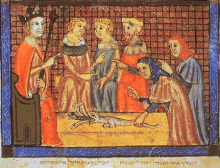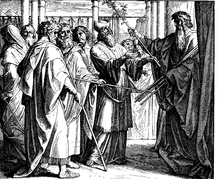
Aaron's rod refers to any of the walking sticks carried by Moses' brother, Aaron, in the Torah. The Bible tells how, along with Moses's rod, Aaron's rod was endowed with miraculous power during the Plagues of Egypt that preceded the Exodus. Later, his rod miraculously sprouted blossoms and almonds to symbolize God's choice of Aaron and his tribe for holy service.
Biblical references

In Israelite culture, the rod (Hebrew: מַטֶּה maṭṭeh) was a natural symbol of authority, as the tool used by the shepherd to correct and guide his flock. Moses, in fact, initially carried his rod while tending his sheep, and later it became his symbol of authority over the Israelites.
The rods of both Moses and Aaron were endowed with miraculous power during the Plagues of Egypt. God commanded Moses to raise his rod over the Red Sea when it was to be split and in prayer over Israel in battle; at Meribah Moses brought forth water from a stone using his rod.

Aaron's rod – perhaps a different rod – reappears in Numbers 16–17. Here Korah's rebellion against Moses's proclamation of the tribe of Levi as the priesthood has been quashed and the entire congregation's ensuing rebellion has resulted in a plague, ended only by the intercession of Moses and Aaron. In order to "stop the complaints" of the Israelites, God commands that each of the Twelve Tribes provide a rod; and only that of the tribe chosen to become priests will miraculously sprout overnight. Aaron provides his rod to represent the tribe of Levi, and "it put forth buds, produced blossoms, and bore ripe almonds", as an evidence of the exclusive right to the priesthood of the tribe of Levi. In commemoration of this decision, it was commanded that the rod be stored "before the testimony".
Aaron's rod is cited as exhibiting miraculous power on its own, when not physically held by its owner. In Exodus 7:10–1, Aaron "cast down his rod" and it became a serpent. When he does so, the Pharaoh's sorcerers counter by similarly casting down their own rods, which also become serpents, but Aaron's rod swallowed them all. Similarly, in Numbers 17:23 it sprouted blossoms when not being held.




In Rabbinical literature
Rabbinic midrash described attributes of Aaron's rod beyond those in the Biblical text.
It is reported that the rod was made of sapphire, weighed forty seahs (a seah = 10.70 pounds), and bore the inscription דצ״ך עד״ש באח״ב (the initials of the Hebrew names of the Ten Plagues).
God created it in the twilight of the sixth day of Creation, and delivered it to Adam when the latter was driven from paradise. After it had passed through the hands of Shem, Enoch, Abraham, Isaac, and Jacob successively, it came into the possession of Joseph. On Joseph's death the Egyptian nobles stole some of his belongings, and, among them, Jethro appropriated the staff. Jethro planted the staff in his garden, when its marvelous virtue was revealed by the fact that nobody could withdraw it from the ground (compare "the sword in the stone"); even to touch it was fraught with danger to life. This was because the Ineffable Name of God was engraved upon it. When Moses entered Jethro's household he read the Name, and by means of it was able to draw up the rod, for which service Zipporah, Jethro's daughter, was given to him in marriage. Her father had sworn that she should become the wife of the man who should be able to master the miraculous rod and of no other.
Aaron's rod, together with its blossoms and fruit, was preserved in the Ark. King Josiah, who foresaw the impending national catastrophe, concealed the Ark and the objects stored with it (Aaron's rod, a vial of manna, and the holy anointing oil). Their whereabouts will remain unknown until, in the Messianic age, the prophet Elijah shall reveal them.
As discussed, the Bible ascribes similar miraculous powers to rods of Aaron and Moses. One midrash goes a step further, and identifies them as being the same rod:
The rod with which Jacob crossed the Jordan (Genesis 32:11) is the same rod which was in Judah's hand (Genesis 38:18), which was in Moses's hand (Exodus 4:20), which was in Aaron's hand (Exodus 7:10), which was in David's hand (1 Samuel 17:40). which was in the hand of each king until the destruction of the Temple, when it was hidden. When the Messiah comes it will be given to him for a scepter in token of his authority over the nations.
According to one midrash, Moses split a tree trunk into twelve portions, and gave one portion to each tribe. When the Rod of Aaron produced blossoms, the Israelites could not but acknowledge the significance of the token. This opinion seemingly assumes that the rod in Korach's rebellion was separate from the rod used for the plagues.
Christian use
Hebrews 9:4 states that Aaron's rod was kept in the Ark of the Covenant.
The account of the blossoming of Aaron's rod contained in Clement's first letter to the Corinthians (ep. 43) is in haggadic-midrashic style, and may probably be ascribed to Jewish or, more strictly speaking, Jewish-Hellenistic sources. According to that account, Moses placed upon each of the twelve staffs the corresponding seal of the head of a tribe. The doors of the sanctuary were similarly sealed, to prevent anyone from having access to the rods at night.
The miraculous flowering of the rod was also considered a type of the Incarnation of Christ and his Virgin Birth, and appears in scenes of the Annunciation to Mary.
In the Ethiopian fourteenth-century text of the Kebra Nagast, Aaron's rod is broken in three and probably a symbol of the Trinity: "The rod of Aaron which sprouted after it had become withered though no one watered it with water, and one had broken it in two places, and it became three rods being one rod."
Islamic literature
Accounts of Aaron's rod appear in Islamic literature. A depiction from al-Tha'labi's (d. 1035, AH 427) Stories of the Prophets depicts Harun (Aaron) leaning on his rod, while his brother Musa's (Moses) staff miraculously turned into a snake-dragon to defeat Pharaoh's magicians.
In modern literature
D. H. Lawrence entitled a novel Aaron's Rod in 1922. This book describes a flautist, Aaron Sissons, and his experiences as he journeys through a Europe exhausted by the First World War. The biblical eponymous reference, with the flute representing a magic rod, is intended to be ironic.
See also
- Caduceus
- Korach (the Torah reading in which Aaron's rod blooms)
- Nehushtan
- Ningizzida
- Rod of Asclepius
- Margna used by Mandaean priests
Notes
- Psalms 2:9, 89:33; Isaiah 10:24, 11:4; Ezekiel 20:37.
- Psalms 23:4.
- Exodus 4:2.
- Exodus 4:20.
- Exodus 7:17, 8:12–13, 9:23, 10:13.
- Exodus 14:16.
- Exodus 17:9.
- Exodus 17:5–6.
- Numbers 17:17–20.
- Numbers 17:23.
- Numbers 17:10.
- ^
 One or more of the preceding sentences incorporates text from a publication now in the public domain: Singer, Isidore; et al., eds. (1906). "Aaron's rod". The Jewish Encyclopedia. New York: Funk & Wagnalls.
One or more of the preceding sentences incorporates text from a publication now in the public domain: Singer, Isidore; et al., eds. (1906). "Aaron's rod". The Jewish Encyclopedia. New York: Funk & Wagnalls.
- ^ Schiller, Gertrud; Selgman, Janet (1971). Iconography of Christian art. Vol.1, Christ's incarnation, childhood, baptism, temptation, transfiguration, works and miracles. Vol. 1. London, England: Lund Humphries. p. 54. OCLC 59999963.
- Tanhuma Vaera 8, ed. Buber.
- Pirkei Avot 5:9.
- ^ Mekhilta, Beshallaḥ, ed. Weiss, 4:60 (on Exodus 16:33).
- Pirkei deRabbi Eliezer 40; Sefer ha-Yashar; Yalkut Shimoni Exodus 168, end.
- Tosefta Yoma 2:13, Sotah 13:2.
- Yalkut Shimoni, Psalms, 869.
- Numbers Rabbah 18:23.
- Budge (Sir), Ernest Alfred Wallis (1922-01-01). The Queen of Sheba & Her Only Son Menyelek: Being the History of the Departure of God & His Ark of the Covenant from Jerusalem to Ethiopia, and the Establishment of the Religion of the Hebrews & the Solomonic Line of Kings in that Country : a Complete Translation of the Kebra Nagast with Introduction. M. Hopkinson.
External links
- Jasher 77 A history of the sapphire stick from Adam to Moses is given in the Book of Jasher.
| Ark of the Covenant topics | |
|---|---|
| People | |
| Lid | |
| Contents | |
| Locations | |
| Related |
|